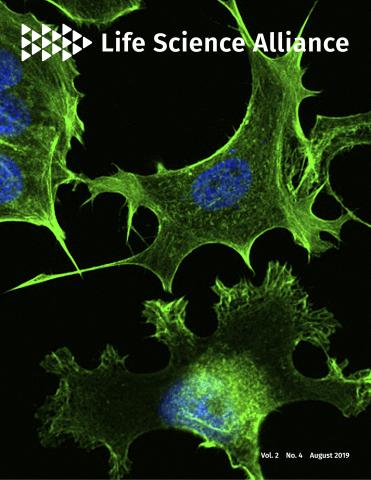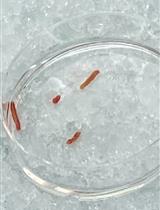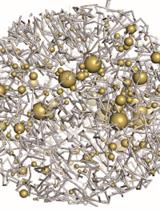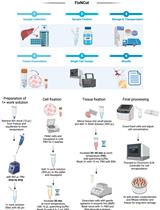- EN - English
- CN - 中文
ChIP-Seq from Limited Starting Material of K562 Cells and Drosophila Neuroblasts Using Tagmentation Assisted Fragmentation Approach
用Tagmentation Assisted Fragmentation法从K562细胞和果蝇神经母细胞的有限起始材料中提取芯片序列
(*contributed equally to this work) 发布: 2020年02月20日第10卷第4期 DOI: 10.21769/BioProtoc.3520 浏览次数: 4648
评审: Imre GáspárPrashanth N SuravajhalaNarendranath Bhokisham
Abstract
Chromatin immunoprecipitation is extensively used to investigate the epigenetic profile and transcription factor binding sites in the genome. However, when the starting material is limited, the conventional ChIP-Seq approach cannot be implemented. This protocol describes a method that can be used to generate the chromatin profiles from as low as 100 human or 1,000 Drosophila cells. The method employs tagmentation to fragment the chromatin with concomitant addition of sequencing adaptors. The method generates datasets with high signal to noise ratio and can be subjected to standard tools for ChIP-Seq analysis.
Keywords: Low Input ChIP-Seq (低细胞量ChIP-Seq)Background
Epigenetic state and transcription factors occupancy are critical determinants of gene expression. To understand this regulation, the precise mapping of chromatin features are very important. Chromatin immunoprecipitation coupled with next generation sequencing is a powerful technique that gives valuable insight into genome wide distributions of chromatin features (Ghavi-Helm et al., 2016). Although powerful, this technique is limited in its application owing to the need of significant starting material which in some conditions are hard to meet, if not completely impossible. This limitation has driven many recent efforts to adapt ChIP-Seq approach for low amount starting material or for rare cell types (Adli et al., 2010; Zheng et al., 2015). One of the key limitations of these efforts is the use of sonication or MNAse for fragmenting the chromatin. The former approach is detrimental for the epitope when present in limited amount as it can lead to destruction of the epitope used for subsequent immunoprecipitation (Stathopulos et al., 2004). The MNAse approach on the other hand is hard to control for its efficacy and saturation. The recent application of CUT&RUN approach was successful in generating profiles from samples of 100 cells using antibody-targeted micrococcal nuclease (Skene et al., 2018). However, all these approaches still resort to ligation-based library preparation approach involving multiple steps, potentially leading to increased variability as well as of loss of complexity (Seguin-Orlando et al., 2013). The method described here overcomes these limitations by using commercially available Tn5 enzyme for fragmenting the chromatin with simultaneous preparation of libraries with fewer intermediate steps. The direct comparison of CUT&RUN approach and TAF-ChIP reveals superior signal to noise ratio in the later, making use of standard bioinformatics pipeline amenable to this approach.
Materials and Reagents
- DNA Low binding 1.5 ml tubes (Eppendorf, catalog number: 0030108051)
- Phase Lock tubes (5Prime, catalog number: 2302830)
- Agencourt AMPure XP Beads (Beckmann Coultier, catalog number: A63381)
- Protein G Dynabeads (Thermo Fisher Scientific, catalog number: 10003D)
- BSA (Sigma-Aldrich, catalog number: A4737)
- Proteinase K (Thermo Fisher Scientific, catalog number: E00491)
- Yeast tRNA (Sigma-Aldrich, catalog number: R8759)
- Anti H3K27Me3 antibody (Active Motif, catalog number: 39155)
- Anti H3 antibody (Abcam, catalog number: ab1791)
- Anti H3K4Me3 antibody (Abcam, catalog number: ab8580)
- Anti H3K9Me3 antibody (Active Motif, catalog number: 39161)
- Collagenase I (Sigma-Aldrich, catalog number: 1148089)
- Papain (Sigma-Aldrich, catalog number: 1495005)
- Primers (Table 1)
Table 1. List of primers with unique barcodesPrimers fw ATAC-seq primer, general, no index AATGATACGGCGACCACCGAGATCTACACTCGTCGGCAGCGTCAGATGT*G rev ATAC-seq primer, Truseq index, 34 CATGGC CAAGCAGAAGACGGCATACGAGATGCCATGGTCTCGTGGGCTCGGAGATG*T rev ATAC-seq primer, Truseq index, 48 TCGGCA CAAGCAGAAGACGGCATACGAGATTGCCGAGTCTCGTGGGCTCGGAGATG*T rev ATAC-seq primer, Truseq index, 22 CGTACG CAAGCAGAAGACGGCATACGAGATCGTACGGTCTCGTGGGCTCGGAGATG*T rev ATAC-seq primer, Truseq index, 15 ATGTCA CAAGCAGAAGACGGCATACGAGATTGACATGTCTCGTGGGCTCGGAGATG*T rev ATAC-seq primer, Truseq index, 46 TCCCGA CAAGCAGAAGACGGCATACGAGATTCGGGAGTCTCGTGGGCTCGGAGATG*T rev ATAC-seq primer, Truseq index, 45 TCATTC CAAGCAGAAGACGGCATACGAGATGAATGAGTCTCGTGGGCTCGGAGATG*T rev ATAC-seq primer, Truseq index, 40 CTCAGA CAAGCAGAAGACGGCATACGAGATTCTGAGGTCTCGTGGGCTCGGAGATG*T rev ATAC-seq primer, Truseq index, 39 CTATAC CAAGCAGAAGACGGCATACGAGATGTATAGGTCTCGTGGGCTCGGAGATG*T rev ATAC-seq primer, Truseq index, 38 CTAGCT CAAGCAGAAGACGGCATACGAGATAGCTAGGTCTCGTGGGCTCGGAGATG*T rev ATAC-seq primer, Truseq index, 37 CGGAAT CAAGCAGAAGACGGCATACGAGATATTCCGGTCTCGTGGGCTCGGAGATG*T rev ATAC-seq primer, Truseq index, 36 CCAACA CAAGCAGAAGACGGCATACGAGATTGTTGGGTCTCGTGGGCTCGGAGATG*T rev ATAC-seq primer, Truseq index, 35 CATTTT CAAGCAGAAGACGGCATACGAGATAAAATGGTCTCGTGGGCTCGGAGATG*T rev ATAC-seq primer, Truseq index, 25 ACTGAT CAAGCAGAAGACGGCATACGAGATATCAGTGTCTCGTGGGCTCGGAGATG*T rev ATAC-seq primer, Truseq index, 26 ATGAG CAAGCAGAAGACGGCATACGAGATGCTCATGTCTCGTGGGCTCGGAGATG*T rev ATAC-seq primer, Truseq index, 27 ATTCCT CAAGCAGAAGACGGCATACGAGATAGGAATGTCTCGTGGGCTCGGAGATG*T rev ATAC-seq primer, Truseq index, 28 CAAAAG CAAGCAGAAGACGGCATACGAGATCTTTTGGTCTCGTGGGCTCGGAGATG*T rev ATAC-seq primer, Truseq index, 23 GAGTGG CAAGCAGAAGACGGCATACGAGATCCACTCGTCTCGTGGGCTCGGAGATG*T rev ATAC-seq primer, Truseq index, 24 GGTAGC CAAGCAGAAGACGGCATACGAGATGCTACCGTCTCGTGGGCTCGGAGATG*T rev ATAC-seq primer, Truseq index, 42 TAATCG CAAGCAGAAGACGGCATACGAGATCGATTAGTCTCGTGGGCTCGGAGATG*T rev ATAC-seq primer, Truseq index, 41 GACGAC CAAGCAGAAGACGGCATACGAGATGTCGTCGTCTCGTGGGCTCGGAGATG*T - NEXTERA XT DNA Library prep Kit (Illumina, catalog number: FC-131-1024)
- NEBNext High-Fidelity 2x PCR Master Mix (New England Biolabs, catalog number: M0541)
- Glycogen (Roche, catalog number: 10901393001)
- 37% Formaldehyde (Sigma-Aldrich, catalog number: F8775)
- Glycine (Sigma-Aldrich, catalog number: 50046)
- Protease Inhibitor Cocktail (Bimake, catalog number: B14001)
- Tris Buffer pH 8.0 (Applichem, catalog number: A4577)
- EDTA (Sigma-Aldrich, EDS catalog number: EDS-500G)
- Sodium Chloride (Sigma-Aldrich, catalog number: S3014)
- Triton X-100 (Sigma-Aldrich, catalog number: T8787)
- 20% sodium dodecyl sulfate (Sigma-Aldrich, catalog number: 05030)
- Nuclease-free water (Qiagen, catalog number: 129115)
- Tris (hydroxymethyl) aminomethane (Sigma-Aldrich, catalog number: 252859)
- N,N-Dimethylformamide (Sigma-Aldrich, catalog number: D4551)
- Qubit dsDNA High Sensitivity Kit (Thermo Fisher Scientific, catalog number: Q33230)
- DNA High Sensitivity Kit for Bioanalyzer (Agilent, catalog number: 5067-4627)
- Schneider’s medium (Thermo Fisher Scientific, catalog number: 21720-001)
- Phenol:Chloroform (Sigma-Aldrich, catalog number: P3803)
- 3 M sodium acetate (Thermo Fisher Scientific, catalog number: AM9740)
- Ethanol (Sigma-Aldrich, catalog number: 51976)
- Hoechst stain (Thermo Fisher Scientific, catalog number: 62249)
- MgCl2 (Sigma-Aldrich, catalog number: 63068)
- Dissociation Solution (see Recipes)
- Blocking Buffer (see Recipes)
- RIPA (140 mM) (see Recipes)
- RIPA (250 mM) (see Recipes)
- TE Buffer (see Recipes)
- Tagmentation Buffer (Home-made) (see Recipes)
Equipment
- DiaMag 0.2 ml-magnetic rack (Diagenode, catalog number: B04000001)
- DynaMag-2 magnetic rack (Thermo Fisher Scientific, catalog number: 12321D)
- Bioruptor plus (Diagenode, catalog number: B01020001)
- Thermomix compact (Eppendorf, catalog number: T1317)
- Bio-Rad PCR Cycler (Bio-Rad, catalog number: C1000)
- Mini tube rotator (Biotools, AG, R2001)
- Tabletop minicentrifuge (Thermo Fisher Scientific, catalog number: 75002478)
- Agilent Bioanalyzer 2100 (Agilent, catalog number: G2939BA)
- Qubit Fluorometer 3 (Thermo Fisher Scientific, catalog number: Q33216)
- Flow cytometer (BD FACS Aria)
Software
- MACS2 (version 2.1.1.20160309, https://github.com/taoliu/MACS)
- Deeptools (version 3.1.3, https://github.com/deeptools/deepTools)
- Samtools (version 1.09, https://github.com/samtools/samtools)
- bowtie2 (version 2.3.5, https://github.com/BenLangmead/bowtie2)
- FastQC (version 0.10.1, https://github.com/s-andrews/FastQC)
Procedure
文章信息
版权信息
© 2020 The Authors; exclusive licensee Bio-protocol LLC.
如何引用
Akhtar, J., More, P. and Albrecht, S. (2020). ChIP-Seq from Limited Starting Material of K562 Cells and Drosophila Neuroblasts Using Tagmentation Assisted Fragmentation Approach. Bio-protocol 10(4): e3520. DOI: 10.21769/BioProtoc.3520.
分类
细胞生物学 > 细胞器分离 > 细胞核
分子生物学 > DNA > DNA 测序
系统生物学 > 基因组学 > 染色质免疫共沉淀测序(ChIP-seq)
您对这篇实验方法有问题吗?
在此处发布您的问题,我们将邀请本文作者来回答。同时,我们会将您的问题发布到Bio-protocol Exchange,以便寻求社区成员的帮助。
Share
Bluesky
X
Copy link













